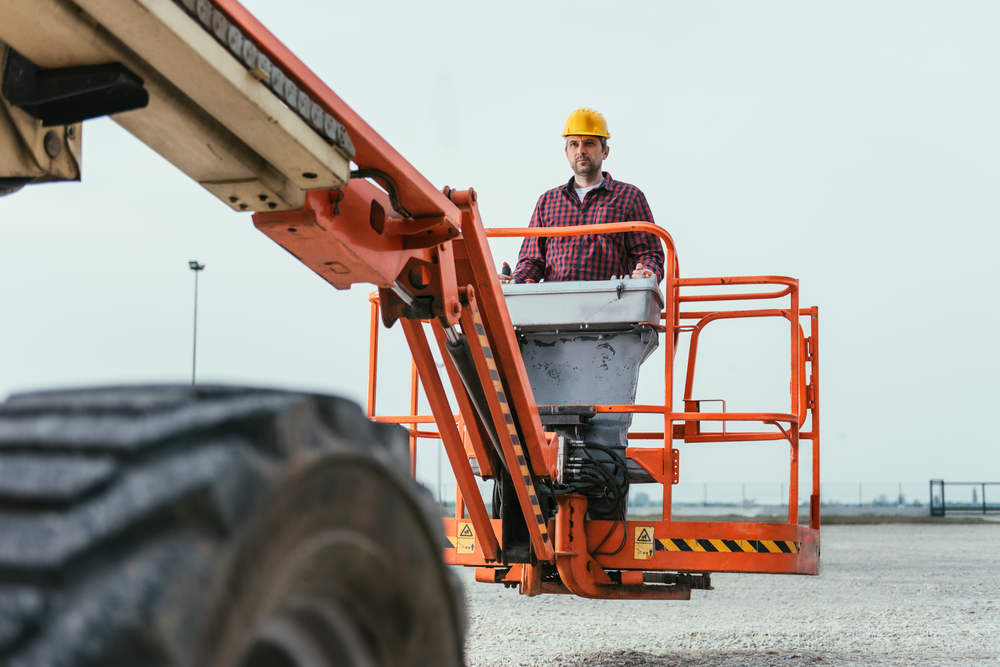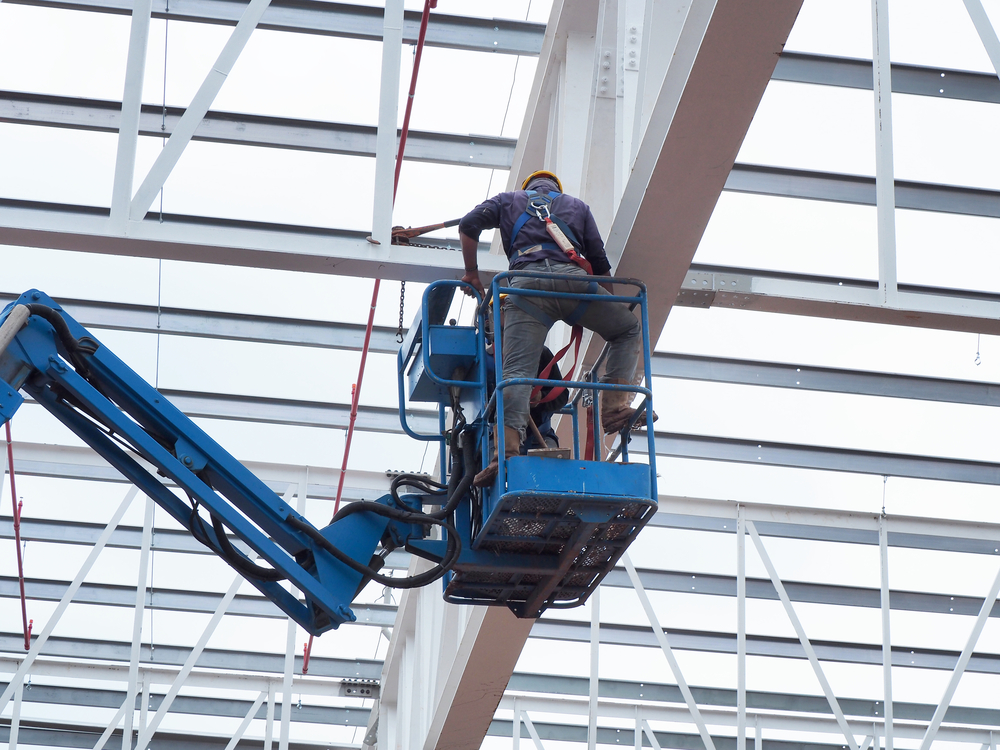Types of Boom Lifts and What They Do – 2025

Understanding What is a Boom Lift
Boom lifts are vehicles that carry workers, their tools, and supplies to their worksite off the ground. There are two main types of boom lifts. Telescopic boom lifts, also known as a straight boom lift or stick boom, have single arms that reach a long distance. They work best in an open area and are stable enough for various terrain.
The second type of boom lift is the articulating boom lift, which is also called a knuckle lift. This lift has segmented arms, which works in tight areas and fits around obstacles. This design allows them to work on more complicated structures and in crowded areas, such as downtown of a busy city.
Boom lifts have the option of diesel, gas, electric and even hybrid power for their source. They may be two- or four-wheel drive to handle all kinds of terrain. They can also come with tires or treads to fit various conditions. You can also choose from various sizes, starting from 30-footers that are low enough and thin enough to fit through a doorway. For the big jobs, you can use a 180-foot boom lift, which has a reach of 19 stories. There is a wide range of boom lift uses, and just as many unique makes and models from which to choose.



What Types of Boom Lifts Are Available?
With “what is a boom lift” answered, you may be wondering about the types of boom lifts available for use on construction sites and in warehouses. The three main kinds include:
1. Articulating Boom Lifts
Also called a “knuckle” boom, this type of lift uses a bucket on a swiveling turntable at the end of an articulating arm. The unique design provides vertical and horizontal flexibility.
An articulating boom has a max vertical reach of 125 ft. and can extend horizontally to 75% of its height. The boom can also be extended in sections, allowing workers to maneuver up and over obstacles. Articulating booms can be used for indoor and outdoor jobs. Indoor models are electrically powered and tend to be smaller than their outdoor counterparts. Outdoor knuckle booms are usually diesel-powered or can be towed to a work site. Whether used indoors or out, the boom lift uses are endless.
Articulating boom lifts can be equipped with a variety of attachments, such as forklifts, cranes, and winches. Be sure to choose a machine that has the right attachments for your specific needs.
2. Telescopic Boom Lifts
One of the most useful types of boom lifts is the telescopic variety. Telescopic boom lifts provide more vertical height than other boom lifts. Like knuckle lifts, telescopic boom lifts have a bucket situated on the end of a telescopic arm, but the arm can only extend in a straight line. During use, the arm goes straight out horizontally, then goes up and down as needed. Because the arm can only move in one direction, telescopic booms are sometimes called “stick” booms.
With platform heights that range from 40 ft. to 80 ft, telescopic booms are ideal for work at tall buildings and other elevated work environments. However, the biggest telescopic boom lifts can reach up to 185 ft. in vertical height, which makes them ideal for a wide range of industrial projects.
To support working safely at heights, telescoping booms tend to have wider bases than articulating lifts. Rough-terrain telescoping booms that use stabilization require a work surface of 10 ft. or more. Yet, because they have a single boom, telescoping booms are easier to operate than articulating booms.
Some common uses for telescopic boom lifts include painting and drywall projects, cleaning windows, and maintenance work.
3. Atrium Lifts
Atrium lifts are a special type of boom lift since they don’t have wheels. Instead, atrium lifts use tracks (like those on excavators) for mobility. This ensures atrium lifts are safe to use on different terrains.
In terms of size and weight, atrium lifts are narrower and lighter than other boom lifts. This lets atrium lifts reach maximum heights of up to 60 ft. In addition, atrium lifts can handle heavy loads and use folding outriggers to keep them anchored in place.
Also, the low ground pressure of atrium lifts allows them to be used indoors and outdoors. The chassis disperses an atrium lift’s weight over a wide area, so it can safely be used on lawns, pavement, marble, and other surfaces. Atrium lifts can be deployed in tight areas where steep surface inclines make it unsafe to use self-propelled or scissor booms as well.
Atrium lifts are typically enclosed in a glass or metal cage and are equipped with safety features such as emergency stop buttons and automatic doors. They are typically powered by electricity, but some models may also be fitted with a backup battery system. Atrium lifts can be customized to meet the specific needs of a building, and are subject to strict safety regulations.
Selecting the Right Boom Lift
As you evaluate the various types of boom lifts and try to determine which is right for your needs, it’s important to ask as many questions as possible. Is the job site indoors or outside? Is the terrain smooth or uneven? What is access to the job site like? Will employees work head-on, underneath, or overhead? Consider mobility, too – will horizontal or vertical mobility be necessary, or will operators simply move straight up and down?
Work requirements should also play a factor in determining which type of boom lift is right for the job. Consider how many workers will need to be on the platform and the types of tools they’ll need to complete their duties. This plays into weight considerations, too. Factor in how much weight the lift will need to carry and the limitations of the job surface. Only once you’ve addressed each of these factors can you truly begin to select the right lift for the job.
How to Drive a Boom Lift
Before starting to operate the boom lift, inspect the condition and ensure all components are operational. This includes checking the fuel level, and condition of the tires, and hoses. To start the lift, turn the remote key switch to Platform Control on the ground control panel. This is the panel to controls the operation of the lift. Pull the red Kill Switch button.
Latch the gate after getting into a work basket. Fasten the lanyard to the D ring, which you’ll find on the platform. Pull the red kill switch, which allows the engine to start and power up the console. Push the start switch for the engine, which usually has a symbol of an engine. Place your foot in the control engage lever, which has a boot-like enclosure. The engine should rev up once you press down.
Begin raising the boom by toggling the joystick, starting out slowly. Select a slow speed if the lift has a speed control, which may be identified by a turtle and rabbit. Toggle the joystick in the direction where you want the boom to move. Then, toggle the right joystick to turn the wheels. The faster you move the joysticks, the faster the machine will move. If you want to operate a boom lift, you will need proper training and certification. This is a dangerous machine, which can cause harm to others and yourself while also putting your worksite in danger of fines from OSHA.
Boom Lift Uses and Advantages


Articulating boom lifts come with their own unique advantages, increased flexibility and maneuverability chief among them. The operator platform and basket can be moved precisely through confined spaces. These tight spaces are part of why it’s so important to learn how to operate a boom lift before using it!
Boom lifts run off a range of different fuel types, too. This diversification allows operators to pick and choose which is best for the job at hand. Diesel lifts are ideal for outdoor projects, while battery electric units are fume-free and safe to use indoors. Hybrid solutions offer additional flexibility, as you can switch back and forth between electric and diesel, depending on whether you’re working indoors or out.
Boom Lifts in Action
Boom lift uses are truly endless. Reporters in Boston were curious about the number of hits the Green Monster wall had taken in its years at Fenway Park. To count the dimples on the face of the wall, the Boston Globe rented a two-person telescopic boom lift to find out. They counted more than 211,000 dents, dings, and dimples. It’s a unique way to use boom lift technology, but hardly the first time such equipment has come in handy at Fenway.
Whether you work for the Boston Globe, Fenway Park, or another organization that uses boom lifts on the job, you’ll need to be properly trained and certified before climbing aboard. OSHA requires every operator to be certified in order to use boom lifts legally. Operators need training to learn how to inspect the vehicle, check for hazards, and avoid accidents. Fail to comply with OSHA regulations, and your business could face expensive penalties. Even if you manage to avoid OSHA inspections, employing uncertified and untrained operators is a fast track to injuries and accidents.
Why Boom Lift Certification Matters
If you or a person you are hiring plans to drive a boom lift, they need to learn how to operate a boom lift first. If a company allows an uncertified operator on a boom lift, they are in violation of OSHA rules. Businesses are audited by OSHA all the time and face penalties and fines if their operators aren’t all certified.
A survey was conducted by CertifyMe with 100 participants. Out of those, 53 had an audit of their safety plan. A total of 85 had been fined by OSHA some time before with 57 of them paying out more than $100,000.
You want to avoid those fines for your business or for your employer by getting certified as a boom lift operator. Boom lift certification protects you, others around you, and your employer.



Learn How to Operate a Boom Lift Now
Regardless of which type of boom lift you choose, be sure to train and certify each operator on the specific model in use. In doing so, you can foster a safe work environment and guard against aerial lift accidents that can lead to injuries and fatalities.
At CertifyMeOnline.net, we offer many safety training courses for all types of aerial lifts. Convenient, affordable online courses make it easier than ever to stay in compliance with OSHA regulations. In about one hour, you can learn everything you need to know about how to operate a boom lift and be ready to get to work.
We even offer a “Train the Trainer” course that’s perfect for educating an entire team of lift operators. If you’re hoping to invest in safety in your organization without shelling out individual training fees for each member of the team, this option is an excellent choice. To find out more, please contact us online or call us today at (602) 277-0615.